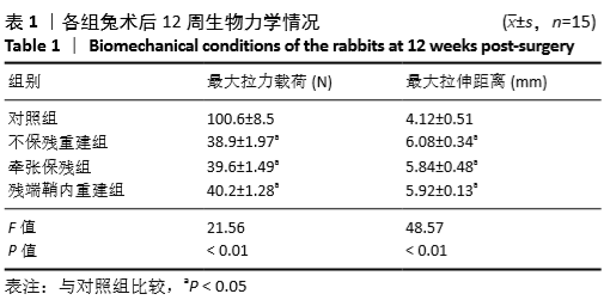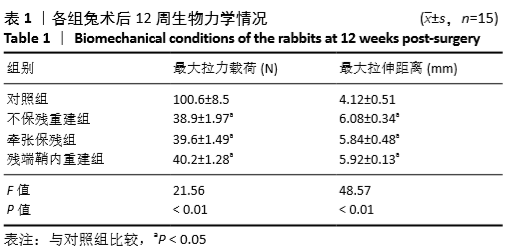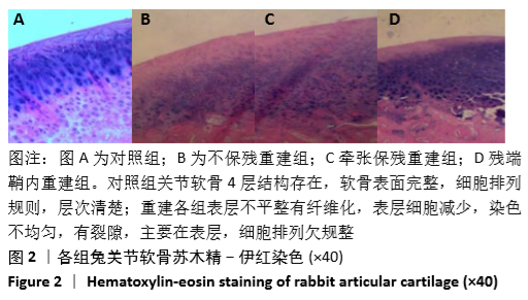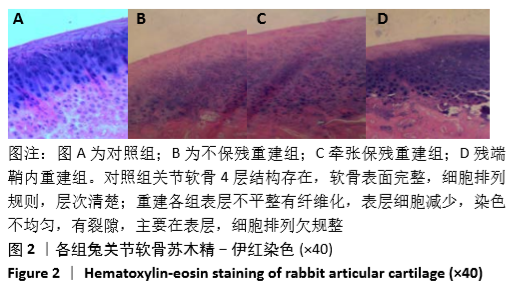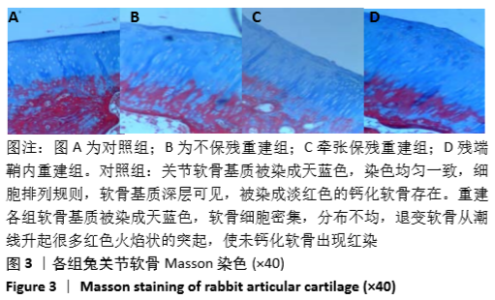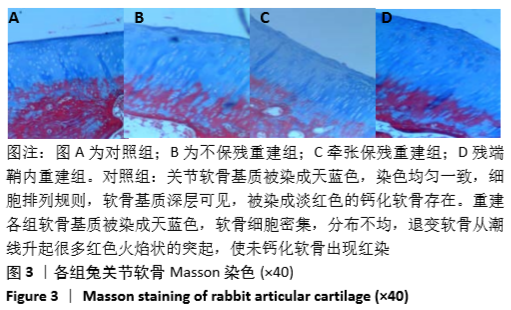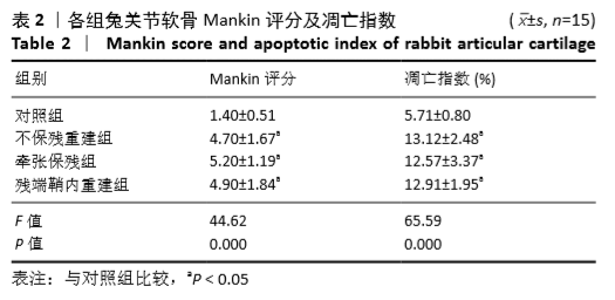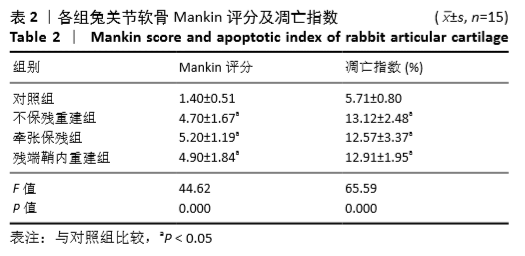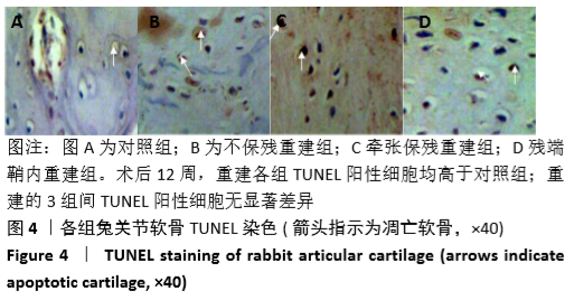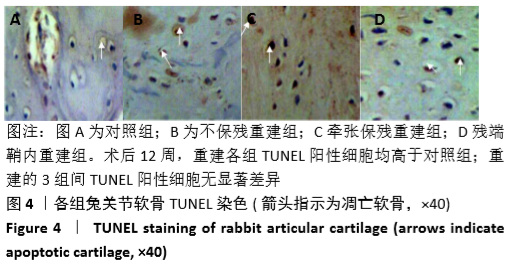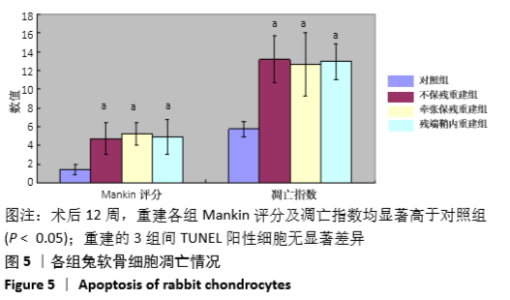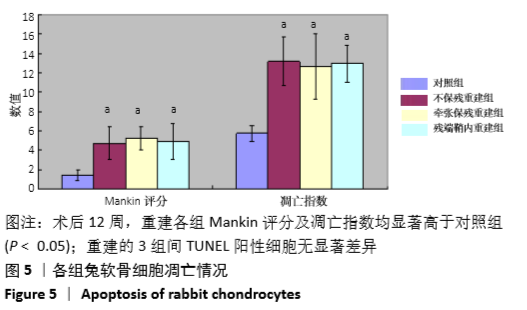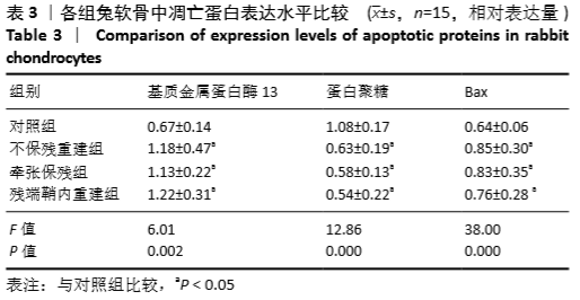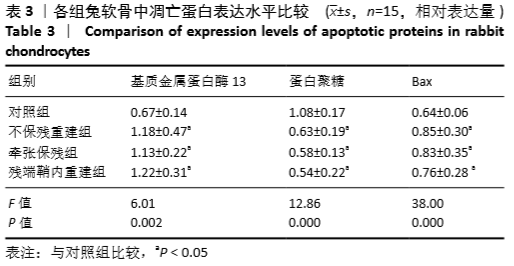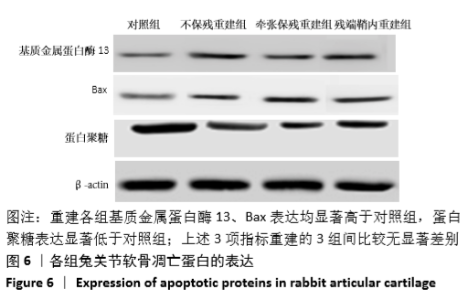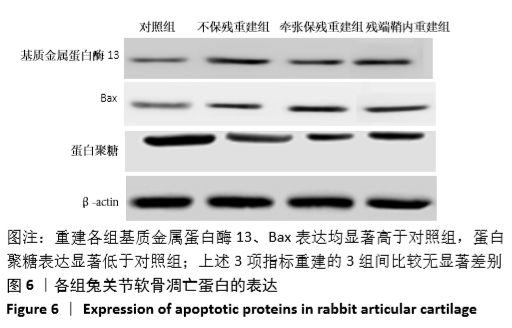Chinese Journal of Tissue Engineering Research ›› 2021, Vol. 25 ›› Issue (5): 735-740.doi: 10.3969/j.issn.2095-4344.3008
Previous Articles Next Articles
Comparison of knee degeneration after anterior cruciate ligament reconstruction with or without remnant preservation
Xie Chongxin, Zhang Lei
- Department of External Medicine, General Hospital of Armed Police Corps, Urumqi 830018, Xinjiang Uygur Autonomous Region, China
-
Received:2020-04-18Revised:2020-04-23Accepted:2020-05-28Online:2021-02-18Published:2020-11-28 -
Contact:Zhang Lei, MD, Attending physician, Department of External Medicine, General Hospital of Armed Police Corps, Urumqi 830018, Xinjiang Uygur Autonomous Region, China -
About author:Xie Chongxin, Attending physician, Department of External Medicine, General Hospital of Armed Police Corps, Urumqi 830018, Xinjiang Uygur Autonomous Region, China -
Supported by:the Natural Science Foundation of Xinjiang Production and Construction Corps, No. 2015AD004
CLC Number:
Cite this article
Xie Chongxin, Zhang Lei. Comparison of knee degeneration after anterior cruciate ligament reconstruction with or without remnant preservation[J]. Chinese Journal of Tissue Engineering Research, 2021, 25(5): 735-740.
share this article
Add to citation manager EndNote|Reference Manager|ProCite|BibTeX|RefWorks
| [1] CHEN K, YIN L, CHENG L, et al. In vivo motion of femoral condyles during weight—bearing flexion after anterior crueiate ligament rupture using biplane radiography.J Sport Sci Med.2013;12(3):579-587. [2] 陈伟,邹刚,刘毅.LARS韧带在前交叉韧带重建中的临床应用与关注热点[J].中国组织工程研究,2020,24(8):1287-1292. [3] LEITER JR, GOURLAY R, MCRAE S, et al. Long-term follow-up of ACL reconstruction with hamstring autograft.Knee Surg Sports Traumatol Arthrosc. 2014;22(5):106l-1069. [4] 李云霞,陈天午,陈世益,等.功能支具对前交叉韧带重建术后膝关节软骨退变和临床预后的影响:基于定量磁共振影像评价的研究[J].中国康复医学杂志,2019,34(8):913-919. [5] SANFORD BA, ZUEKER-LEVIN AR, WILLIAMS JL, et al. Printipal component analysis of knee kinematics and kinetics after anterior cruciate ligament reconstruction.Gait & Posture.2012;36(3):609-613. [6] DENEWETH JM, BEY MJ, MCLEAN SG, et al. Tibiofemoral joint kinematics of the anterior cruciate ligament-reconstructed knee during a single-legged hop landing.Am J Sports Med. 2010;38(9):1820-l828. [7] 李磊,吴昊.前交叉韧带保留残端重建术治疗前交叉韧带损伤的研究[J].实用骨科杂志,2019,25(12):1067-1072. [8] 陈均源,杨杰,李劼若,等.关节镜下前交叉韧带重建保留与不保留残端临床疗效比较的Meta分析[J].中国循证医学杂志,2016,16(2): 153-159. [9] LEE BI, MIN KD, CHOI HS, et al. Arthroscopic anterior cruciate ligament reconstruction with the tibial-remnant preserving technique using a hamstring graft. Arthroscopy. 2006;22(3):340.e1-347. [10] AHN JH, WANG JH, LEE YS, et al. Anterior cruciate ligament reconstruction using remnant preservation and a femoral tensioning technique: clinical and magnetic resonance imaging results.Arthroscopy. 2011;27(8): 1079-1089. [11] IMHAUSER C , MAURO C, CHOI D, et al. Abnormal Tibiofemoral Contact Stress and Its Association With Altered Kinematics After Center-Center Anterior Cruciate Ligament Reconstruction: An in Vitro Study.Am J Sports Med. 2013;41(4):815-825 . [12] BUTLER RJ, MINICK KI, FERBER R, et al. Gait mechanics after ACL reconstruction:implications for the early onset of knee osteoarthritis.Br J Sports Med. 2009;43(5):366- 370. [13] HART HF, CULVENOR AG, COLLINS NJ, et al . Knee kinematics and joint moments during gait following anterior cruciate ligament reconstruction: a systematic review and meta-analysis.Br J Sports Med. 2016;50(10): 597-612. [14] BJÖRNSSON H, SAMUELSSON K, SUNDEMO D, et al. A Randomized Controlled Trial With Mean 16-Year Follow-up Comparing Hamstring and Patellar Tendon Autografts in Anterior Cruciate Ligament Reconstruction. Am J Sports Med. 2016;44(9):2304-2313. [15] KARIKIS I, DESAI N, SERNERT N, et al. Comparison of Anatomic Double-and Single-Bundle Techniques for Anterior Cruciate Ligament Reconstruction Using Hamstring Tendon Autografts:A Prospective Randomized Study With 5-Year Clinical and Radiographic Follow-up. Am J Sports Med.2016; 44(5):1225-1236. [16] JANSSEN PA, DU MÉE A, VAN VALKENBURG J, et al. Anterior cruciate ligament reconstruction with 4-strand Hamstring autograft and accelerated rehabilitation:a 10-year prospective study on clinical results, knee osteoarthritis and its predictors. Knee Surg Sports Traumatol Arthrosc. 2013; 21(9):1977-1988 [17] GERHARD P, BOLT R, DUCK K, et al. Long-term results of arthroscopically assisted an atomical single-bundle anterior cruciate ligament reconstruction using patellar tendon auograft: arethere any predictors for the development of osteoarthritis?.Knee Surg Sports Traumatol Arthrosc. 2013;21(4):957-964. [18] HWANG HS, KIM HA. Chondrocyte Apoptosis in the Pathogenesis of Osteoarthritis.Int J Mol Sci. 2015;16(11):26035-26054. [19] 余光书,林焱斌,熊国胜,等.补骨颗粒含药血清对大鼠软骨细胞凋亡及 Trx2 信号通路的影响[J].中国骨质疏松杂志,2019,25(6):753-757. [20] 谢文鹏,徐龙进,王象鹏,等.p38 MAPK 信号通路在膝关节骨性关节炎中医药诊疗中的作用[J].中国实验方剂学杂志,2019,25(8):219-223. [21] 唐芳,马武开,卢向阳,等.中药塌渍对膝骨关节炎兔 MMP-3、MMP-13、BMP-2、cylinD1、c-myc表达的影响[J].中国老年学杂志,2019,39(3): 614-618. [22] 欧国峰,董博,刘继华,等.膝骨性关节炎患者关节液中miRNA- 146a、MMP-13的表达分析及相关性研究[J].中医药导报,2018,24(6):13-16. [23] 刘乃刚,于佳妮,胡 波,等.针刀对膝骨关节炎兔软骨细胞磷酸化黏着斑激酶、磷酯酰肌醇-3激酶、聚集蛋白聚糖基因及蛋白表达的影响[J].针刺研究,2018,43(4):221-225. [24] OLTVAL ZN, MILLIMAN CI. KORSMCYER SJ. Bcl-2 heterodimerizes in vivo with a conserved homdogy,Bax.that accelreates prcgrammed cell death.Cell.1993;74(4):609-619. [25] CAI XY, XIA Y, YANG SH, et al. Ropivacaine and bupivacaine-induced death of rabbit annulus fibrosus cells in vitro: involvement of the mitochondrial apoptotic pathway.Osteoarthritis Cartilage.2015;23(10):1763-1775 [26] BREW CJ, CLEGG PD, BOOT-HANDFORD RP, et al. Gene expression in human chondrocytes in late osteoarthritis is changed in both fibrillated and intact cartilage without evidence of generalised chondrocyte hypertrophy. Ann Rheum Dis. 2010;69(1):234-240. [27] MURRAY MM, SPINDLER KP, BALLARD P, et al. Enhanced histologic repair in a central wound in the anterior cruciate ligament with a collagen-platelet-rich plasma scaffold.J Orthop Res.2007;25:1007-1017. [28] SONG GY, ZHANG J, LI X, et al. Acute Anterior Cruciate Ligament Reconstruction With an Augmented Remnant Repair: A Comparative Macroscopic and Biomechanical Study in an Animal Model.Arthroscopy. 2014;30(3):344-351 [29] TIE K, CHEN LB, HU DC, et al. The difference in clinical outcome of single-bundle anterior cruciate ligament reconstructions with and without remnant preservation:A meta-analysis.The Knee.2016;23:566-574. [30] MAEDA S, ISHIBASHI Y, TSUDA EI, et al. Intraoperative navigation evaluation of tibial translation after resection of anterior cruciate ligament remnants. Arthroscopy.2011;27(9):1203-1210. |
| [1] | Hu Kai, Qiao Xiaohong, Zhang Yonghong, Wang Dong, Qin Sihe. Treatment of displaced intra-articular calcaneal fractures with cannulated screws and plates: a meta-analysis of 15 randomized controlled trials [J]. Chinese Journal of Tissue Engineering Research, 2021, 25(9): 1465-1470. |
| [2] | Huang Dengcheng, Wang Zhike, Cao Xuewei. Comparison of the short-term efficacy of extracorporeal shock wave therapy for middle-aged and elderly knee osteoarthritis: a meta-analysis [J]. Chinese Journal of Tissue Engineering Research, 2021, 25(9): 1471-1476. |
| [3] | Xu Feng, Kang Hui, Wei Tanjun, Xi Jintao. Biomechanical analysis of different fixation methods of pedicle screws for thoracolumbar fracture [J]. Chinese Journal of Tissue Engineering Research, 2021, 25(9): 1313-1317. |
| [4] | Jiang Yong, Luo Yi, Ding Yongli, Zhou Yong, Min Li, Tang Fan, Zhang Wenli, Duan Hong, Tu Chongqi. Von Mises stress on the influence of pelvic stability by precise sacral resection and clinical validation [J]. Chinese Journal of Tissue Engineering Research, 2021, 25(9): 1318-1323. |
| [5] | Zhang Tongtong, Wang Zhonghua, Wen Jie, Song Yuxin, Liu Lin. Application of three-dimensional printing model in surgical resection and reconstruction of cervical tumor [J]. Chinese Journal of Tissue Engineering Research, 2021, 25(9): 1335-1339. |
| [6] | Zhang Yu, Tian Shaoqi, Zeng Guobo, Hu Chuan. Risk factors for myocardial infarction following primary total joint arthroplasty [J]. Chinese Journal of Tissue Engineering Research, 2021, 25(9): 1340-1345. |
| [7] | Wei Wei, Li Jian, Huang Linhai, Lan Mindong, Lu Xianwei, Huang Shaodong. Factors affecting fall fear in the first movement of elderly patients after total knee or hip arthroplasty [J]. Chinese Journal of Tissue Engineering Research, 2021, 25(9): 1351-1355. |
| [8] | Wang Jinjun, Deng Zengfa, Liu Kang, He Zhiyong, Yu Xinping, Liang Jianji, Li Chen, Guo Zhouyang. Hemostatic effect and safety of intravenous drip of tranexamic acid combined with topical application of cocktail containing tranexamic acid in total knee arthroplasty [J]. Chinese Journal of Tissue Engineering Research, 2021, 25(9): 1356-1361. |
| [9] | Xiao Guoqing, Liu Xuanze, Yan Yuhao, Zhong Xihong. Influencing factors of knee flexion limitation after total knee arthroplasty with posterior stabilized prostheses [J]. Chinese Journal of Tissue Engineering Research, 2021, 25(9): 1362-1367. |
| [10] | Huang Zexiao, Yang Mei, Lin Shiwei, He Heyu. Correlation between the level of serum n-3 polyunsaturated fatty acids and quadriceps weakness in the early stage after total knee arthroplasty [J]. Chinese Journal of Tissue Engineering Research, 2021, 25(9): 1375-1380. |
| [11] | Zhang Chong, Liu Zhiang, Yao Shuaihui, Gao Junsheng, Jiang Yan, Zhang Lu. Safety and effectiveness of topical application of tranexamic acid to reduce drainage of elderly femoral neck fractures after total hip arthroplasty [J]. Chinese Journal of Tissue Engineering Research, 2021, 25(9): 1381-1386. |
| [12] | Wang Haiying, Lü Bing, Li Hui, Wang Shunyi. Posterior lumbar interbody fusion for degenerative lumbar spondylolisthesis: prediction of functional prognosis of patients based on spinopelvic parameters [J]. Chinese Journal of Tissue Engineering Research, 2021, 25(9): 1393-1397. |
| [13] | Lü Zhen, Bai Jinzhu. A prospective study on the application of staged lumbar motion chain rehabilitation based on McKenzie’s technique after lumbar percutaneous transforaminal endoscopic discectomy [J]. Chinese Journal of Tissue Engineering Research, 2021, 25(9): 1398-1403. |
| [14] | Chen Xinmin, Li Wenbiao, Xiong Kaikai, Xiong Xiaoyan, Zheng Liqin, Li Musheng, Zheng Yongze, Lin Ziling. Type A3.3 femoral intertrochanteric fracture with augmented proximal femoral nail anti-rotation in the elderly: finite element analysis of the optimal amount of bone cement [J]. Chinese Journal of Tissue Engineering Research, 2021, 25(9): 1404-1409. |
| [15] | Du Xiupeng, Yang Zhaohui. Effect of degree of initial deformity of impacted femoral neck fractures under 65 years of age on femoral neck shortening [J]. Chinese Journal of Tissue Engineering Research, 2021, 25(9): 1410-1416. |
| Viewed | ||||||
|
Full text |
|
|||||
|
Abstract |
|
|||||


